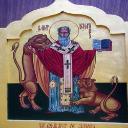Yahoo Answers is shutting down on May 4th, 2021 (Eastern Time) and beginning April 20th, 2021 (Eastern Time) the Yahoo Answers website will be in read-only mode. There will be no changes to other Yahoo properties or services, or your Yahoo account. You can find more information about the Yahoo Answers shutdown and how to download your data on this help page.
Trending News
Why do so many Protestant Bibles have the word "Image" added when it was never in the original text?
Most Protestants accuse the Catholic Church of adding and removing from the Bible. Though most Protestant bibles have the word "image" added to Exodus xx. 4 & Deut. v. 8.
e.g.,
English Standard Edition
4"You shall not make for yourself a carved image, or any likeness of anything that is in heaven above, or that is in the earth beneath, or that is in the water under the earth.
8"'You shall not make for yourself a carved image, or any likeness of anything that is in heaven above, or that is on the earth beneath, or that is in the water under the earth.
21 KJV; KJV; NKJV
4"Thou shalt not make unto thee any graven image, or any likeness of anything that is in heaven above, or that is in the earth beneath, or that is in the water under the earth.
4Thou shalt not make unto thee any graven image, or any likeness of any thing that is in heaven above, or that is in the earth beneath, or that is in the water under the earth.
4“You shall not make for yourself a carved image—any likeness of anything that is in heaven above, or that is in the earth beneath, or that is in the water under the earth;
8Thou shalt not make thee any graven image, or any likeness of any thing that is in heaven above, or that is in the earth beneath, or that is in the waters beneath the earth.
8Thou shalt not make thee any graven image, or any likeness of any thing that is in heaven above, or that is in the earth beneath, or that is in the waters beneath the earth:
8 ‘You shall not make for yourself a carved image—any likeness of anything that is in heaven above, or that is in the earth beneath, or that is in the water under the earth;
American Standard (ASE) ; NASE
4Thou shalt not make unto thee a graven image, nor any likeness of any thing that is in heaven above, or that is in the earth beneath, or that is in the water under the earth.
4“You shall not make for yourself [a]an idol, or any likeness of what is in heaven above or on the earth beneath or in the water under the earth.
[a] Exodus 20:4 Or a graven image
8 Thou shalt not make unto thee a graven image, nor any likeness of anything that is in heaven above, or that is in the earth beneath, or that is in the water under the earth:
8 ‘You shall not make for yourself [a]an idol, or any likeness of what is in heaven above [b]or on the earth beneath [c]or in the water under the earth.
[a]Deuteronomy 5:8 Or a graven image
[b]Deuteronomy 5:8 Lit or what is
[c]Deuteronomy 5:8 Lit or what is
NIV
4“You shall not make for yourself an image in the form of anything in heaven above or on the earth beneath or in the waters below.
8 “You shall not make for yourself an image in the form of anything in heaven above or on the earth beneath or in the waters below.
Data obtained from http://www.biblegateway.com/ , accessed on July 17, 2011 @ 2100 hrs.
The Latin Vulgate uses the word Sulptile which a direct translation of the Hebrew פֶסֶל (pesel) and literally means "Graven Thing" or "Carved Thing" that which is used as an idol. The Greek uses the word "ἔιδωλον" or Idol.
If the Latin were to conform to "Graven Image" it would have to read as Imaginem Sculptum. Sculptile (sculptulis) and Sculptus (sculpta \ sculptum) sound very similar, because Sculptus is the root for Sculptile. Sculptus alone literally means graven (carving).
So why is the word "image" added to your bibles?
I never said the original was English or Latin. Why do you think I gave the Hebrew פֶסֶל which the Latin is a direct (literal) translation.
I do know that there are some Catholic Bibles out there which have also been poorly translated as well e.g., the New Jerusalem Bible, though many Protestants like to ask why Catholics add and remove from the bible, yet most don't even realize that their own bibles are tainted.
<<How does the word 'image' make a difference?>>
The very fact that the word [image] itself is an addition. Sculptile does not mean "Graven Image," it literally mean "Graven Thing" which is an "Idol," Thus I explained that Imaginem Sculptum, means Graven Image. Also the most correct English translation of Pesel (פֶסֶל) is "Graven Thing," that is why St. Jerome used Sculptile and not Imaginem Sculptum.
<<also "pesel" better translates as "idol" or "image.">>
That is incorrect. It does mean idol, yes. Image, no. Only from the reformation 16th century has Pesel gotten the meaning of Image. Even some erroneously translate Sculptile as "Graven Image" also. Just because someone erroneously translates something, never make it correct no matter how many people believe it or back it. For Pesel the best translation is "Graven Thing."
10 Answers
- imacatholic2Lv 710 years agoFavorite Answer
I would guess because the word "image" would condemn any kind of religious art (as in Catholic art) and not just Pagan idols.
With love in Christ.
- Anonymous5 years ago
The KJV has added whole verses what is going to happen to people who use this bible? When comparing the NIV, KJV, NASB & NWT translations of Col 1:15-19. only the NIV 'added words that changed the meaning of the original. per Jason BeDuhn. Concerning the NIV: Bruce Metzger: (NIV) "It is surprising that translators who profess to have 'a high view of scripture" should take liberties with text by omitting words or, more often, by adding words that are not in the manuscripts." Why don't people complain about the NIV? Because most don't know better, and it also agrees with their theology. What is going to happen to those who use this bible? .
- lyn1136Lv 710 years ago
GRAVEN THING comes directly from the first English translation, the Rheims Old Testament, 1603, i.e., the Olde Englifhe: (substitute f for s and v for u)
2. "I am the Lord thy God, which brought thee forth out of the Land of Aegypt, out of the houfe of feruitude. 3. Thou fhalt not haue "ftrange Gods before me. 4. Thou fhalt not make to the" a grauen thing, nor any fimiltude that is in heaven above & that is in the earth beneath, neither of thofe things that are in the waters vnder the earth.] ...."
[2. "I am the Lord thy God, which brought thee forth out of the Land of Egypt, out of the house of servitude. 3.Thou shalt not have "strange Gods before me. 4. Thou shalt not make to the" a graven thing, nor any similitude that is in heaven above, & that is in the earth beneath, neither of those things that are in the waters under the earth.]
The word was NOT translated by St. Jerome as "image," In 1583 the word was shown in the Vulgate as above (graven). I am reading from the Old English Texte but Luther spoke and read Latin, before the Vulgate was translated to Englishe at Rheims, translated by the heretic ex-priest Euseubius. I do not have an Euseubius translation, but someone check to see if "image" is in it. If it is, then the Protestants of Scotland who rewrote the KJV may have copied Euseubius.
And I agree, the House of David retained the first scriptures in Hebrew. Many of the Apostles WERE Hebrew, too.
Traditional Catholics of Trent at traditionalmass.org/
- TruthRevealedLv 510 years ago
It's much easier to point out that they took 7 books out of the Bible and that the KJV has the erroneous line saying "there are three that bear witness in heaven. The Father, Son, and Holy Spirit." (paraphrased). This is known to be a fraudulent line used to add biblical credence to the trinity (although I do believe in the trinity).
Also, Luther added the word 'alone' after every instance of 'faith' in his translation.
- How do you think about the answers? You can sign in to vote the answer.
- 10 years ago
Looks to me like your Latin vulgate was the one that did the adding; it most certainly was NOT "the original."
To wit:
לֹא תַעֲשׂוּן, אִתִּי: אֱלֹהֵי כֶסֶף וֵאלֹהֵי זָהָב, לֹא תַעֲשׂוּ לָכֶם. <<< Original Hebrew (pointed text)
You will not do, with me: God of silver and gods of gold, do not you. <<< Literal, word-for-word translation of the Hebrew into English.
So why did YOUR "original" add all those words?
Word-for-word translations don't work; otherwise, we could use a computer to do it. In English, the intent has to be conveyed in slightly different phrasing. If you don't get Hebrew and/or the process of translation, then you really don't have a clue what you're talking about.
And I'm Jewish, not Christian.
- Anonymous10 years ago
How does the word 'image' make a difference?
Every Bible translation adds and removes words from the original text for the sake of making it less awkward to read in Latin-based languages.
Source(s): http://www.biblecritic.net/ - DonaldLv 610 years ago
Image is in the original manuscripts.
Why is it the catholics hate the Bible? Why do they refuse to believe what God says in the bible is the truth?
Read the Bible, ask the Holy Spirit to tell you what it says instead of listening to the catholic church.
- РобертLv 710 years ago
.
YOU LIE.
I only need ONE Bible, unlike you quoting from many -
The King James Bible is know as the MOST ACCURATE Bible.
Exodus 20:4 the word from which "Image" is translated IS:
pesel; A Hebrew word meaning an idol: - carved (graven) image.
Please do som research . . .
.
- ?Lv 510 years ago
The "Protestant Bibles" are actually directly translated from the Hebrew and Greek, as opposed to the Vulgate. Also, "pesel" better translates as "idol" or "image."
- Anonymous10 years ago
The orginal was never english or latin
straining gnats






